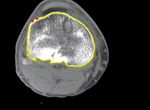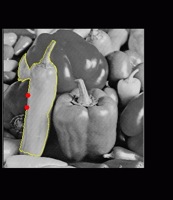Interactive Image Segmentation
Segmentation is an important computer vision problem. Despite intensive research for several decades, the problem stubbornly insists on being unsolved for arbitrary images. Early on, researchers realized that human input could be valuable in steering the segmentation process in order to obtain more easily and reliably accurate results according to our visual perception. This has led to the development of interactive methods like snakes, intelligent scissors and more recently interactive graph cuts. Clearly, the human can manually delineate the boundary of any object; however this is a tedious, time-consuming and error-prone process. Therefore, the goal of an interactive segmentation method should be to delineate an object boundary with the minimum amount of human effort.


In this project we focus on boundary-based segmentation criteria for which the global optimum can be efficiently found using shortest paths algorithms. These criteria assume that the input provided by the user consists of points on the boundary of the object to be segmented. Although such criteria have been successfully employed in the past (eg. Intelligent Scissors), for geometrically complex objects it can be the case that significant amount of human input is required. To address this issue we have developed a statistical criterion whose underlying model is a discriminative Markov model similar in spirit to the Maximum Entropy Markov Models (MEMM). For the particular problem the interesting quantity is the normalization factor of the transition probabilities; this quantity boosts the probability of a particular boundary segment based on the candidate boundary segments in its vicinity. We also aim at providing a theoretically framework that will assist us in studying the effectiveness of boundary, graph-based criteria. To this end, we have defined the "contrast of weighted paths" as the absolute difference of the cost of two paths consisting of the same number of edges. Defining weights that increase this quantity may reduce the amount of human input required to extract a boundary. Finally, we have developed a hierarchical extension of our criterion in order to enhance its effectiveness and robustness.
Some results can be seen below. The red dots indicate where the user clicked to provide information about the boundary and the yellow contour indicates the boundary found by our method.





• Christina Pavlopoulou

C. Pavlopoulou, and A. C. Kak, "Globally Optimal Interactive Boundary Extraction Using Markov Chain Modeling," CVPR Workshop on Perceptual Organization in Computer Vision, 2006 [pdf]
C. Pavlopoulou, A. C. Kak and C. Brodley, "Application of Semi-supervised and Active Learning to Interactive Contour Delineation" in Proceedings ICML-EDDS Workshop on the Continuum from Labeled Data to Unlabeled Data, Washington DC, 2003. [pdf][ps]
C. Pavlopoulou, A. C. Kak and C. Brodley, "An Interactive Framework for Boundary Delineation for Medical CBIR", in Proceedings IEEE Workshop on Content-Based Access of Image and Video Databases, Hawaii, 2001. [pdf]
